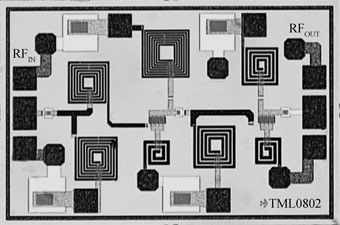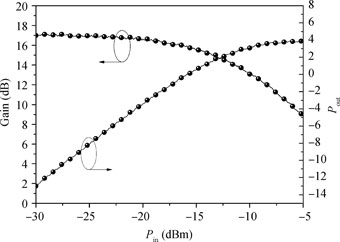- News
30 October 2012
Low noise and low power consumption with pseudomorphic HEMTs
Researchers in China have designed and constructed a two-stage 2.5-5GHz low-noise amplifier (LNA) using enhancement-mode (normally-off) aluminium gallium arsenide (AlGaAs) pseudomorphic high-electron-mobility transistors (pHEMTs) [Peng Yangyang et al, J. Semicond., vol33, p105001, 2012]. The researchers comment: “According to the author’s knowledge, this is the lowest-power-consumption LNA fabricated in 0.5μm AlGaAs/GaAs pHEMT [technology] with comparable performance.”
LNAs have many wireless applications such as radar (S-band 2-4GHz; C-band 4-8GHz), ultra-wideband data communications, and software-defined radios.
Gallium arsenide monolithic microwave integrated circuit (MMIC) technology competes against silicon technology and may soon have to seriously contend with gallium nitride (GaN) devices. Although silicon-based components can achieve cut-off frequencies up to 300GHz, GaAs technology is widely used in critical components for microwave and millimeter-wave application due to its greater reliability and high yield. GaN devices can achieve higher gain, but at higher cost and with higher power consumption.
 Figure 1: Chip photograph of LNA.
Figure 1: Chip photograph of LNA.
Zhejiang–California Nanosystems Institute and Zhejiang University jointly developed the circuit that included on-chip capacitors and inductors, and measured 1.5mm x 1mm (Figure 1).The design aimed at flat gain over a frequency range and standard 50Ω impedance matching for the input and output. A wideband matching network and a negative feedback were used to achieve the researchers’ aims of wide operation bandwidth and low noise figure.
The average small-signal gain of the circuit was 17dB with flatness of 1.6dB over the frequency range 2.5-5GHz. The input and return losses over this band were less than 10dB. The bias conditions were achieved with 1.5V power supply (VDD), giving a gate bias of 0.7V and drawing a total current of 22mA (IDD).
 Figure 2: Power performance of the LNA at 4GHz.
Figure 2: Power performance of the LNA at 4GHz.
The noise figure was 2.4dB to 3dB for frequencies from 2.5GHz to 5GHz at a current bias of 33mA. From power performance measurements (Figure 2), the 1 dB compression point (P1dB, the power level that causes the gain to drop by 1 dB from its small-signal value) was found to be 2.3dBm with total power consumption of 33mW. Another measure of non-linearity/gain compression, the third-order intercept point (IIP3), was -2dBm.
http://iopscience.iop.org/1674-4926/33/10/105001
The author Mike Cooke is a freelance technology journalist who has worked in the semiconductor and advanced technology sectors since 1997.


